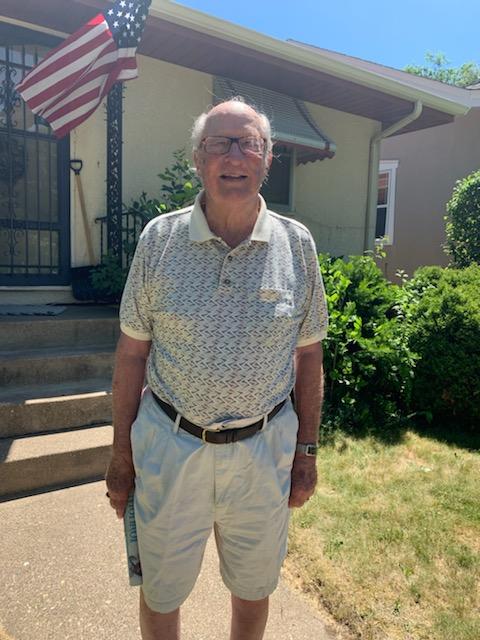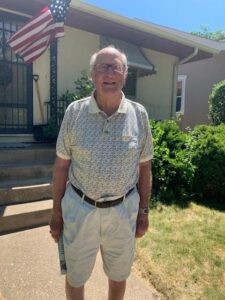Bob on Albert Street
By Sarah O’Brien

Bikes, planes, streetcars and golf carts. These modes of transportation peppered a chance conversation I had with my neighbor Bob, whose recollections of living in our neighborhood go back 80+ years. As a child Bob lived on Iowa Ave. He had just turned 9 years old and joined the Cub Scouts when the Japanese attacked Pearl Harbor. At that time Bob really wanted a bike but because of the limitations due to the war, “You couldn’t buy bicycles. My dad got me an old junky bike. I hated it because it was so old. By the time the war was over I was out of the bike age. I wanted a car! I never got one [in my youth] but I wanted one.”
As an adult Bob purchased his home on Albert Street where he and his late wife raised their children. “The [land that I live on now] didn’t have a house on it when I was a kid,” Bob shared. “It was a vacant lot that was called “the little hill” because it has a slope on it and it was the hill to learn how to sled on. When [kids] got older they would go over to the golf course to sled.”
It is hard to imagine anything other than houses set next to one another in tidy rows with cars alongside curbs lining our blocks, but Bob describes other worlds and other lives lived before the homes we live in even became a plan. According to Bob, in the early 1900’s this area was considered “the boondocks” compared to the Midway where there were small shops on Lexington and University and the first A&P Supermarket went up. Then between 1915-1925 the Midway area developed further as homes were built where the streetcar lines were.
“People used streetcars to get around. People took the streetcar downtown to shop – there weren’t malls at that time – to school, and if you wanted to see friends, you took the streetcar. You had to connect to go downtown. There was the Snelling Avenue [line] to hook up with the Como or the Hamline-Cherokee or the University [lines]. There were nine streetcar lines that went like spokes into downtown.”
Bob went on to share that his section of the block used to be a farm and across the street from his house stands the original farmhouse known as the Robertson Farmhouse. Some of the nearby homes are the outbuildings of the farm. “At least that’s what we have been told,” he explained.
At Snelling and Larpenteur, just a few blocks from Bob’s house, there was an airport. “It was called Curtiss Northwest Airport,” he recalled. “Curtiss was the name of an airplane manufacturer in WWI. The government had all of the WWI airplanes and sold them to Curtiss airport. Prior to being an airfield it was a nursery for trees and plants.” That spot is now Curtiss Field, a quaint neighborhood park. After WWII the government offered the land for a Victory Garden where California Avenue is now. “You could plant whatever you wanted. It was open all the way from Snelling to Larpenteur.”
Asked how the pandemic has been for him, Bob replied with a chuckle, “Well I haven’t gotten it!” Nevertheless, there are some things he has had to do without, like movies. “I shouldn’t tell you all my secrets but years ago a small department store went out of business up where the Cub store is on Larpenteur. A lady bought the building and turned it into a neighborhood movie theater. It was beautiful! She offered bargain rates at $1-2. She would break even with the movies but she made profits on concessions. It was so handy having a movie theater there! I haven’t been to the movies for a long time, but now [because of the pandemic] you can’t go.”
“They don’t put this in the paper,” he continued, “but it is difficult to get an [COVID-19 vaccination] appointment.” Still, Bob recently got vaccinated, and the experience reminded him of his time in the military. “We had guys that probably milked cows before going into the service and they made them combat medics.They gave you all your shots. All of a sudden they would line you up and say we are going over to the clinic; we are signed up for shots. The whole company would march over and get in line and go through and roll up both sleeves. And one medic would give you a shot in the left arm and another medic would give you a shot in the right arm, and then the next day we are supposed to go out and qualify shoot on the firing range and your arms are sorer than heck! I don’t think they used sharp needles but what could you say – you were in the service! When I go to get the flu shot nowadays, the person doing it to ya, they always say we can always tell the people in the service – they roll up their sleeve and go. I always say, ‘We had no choice!’” Bob says with a laugh.
Bob has enjoyed his neighborhood of 80+ years. One of his favorite pastimes is golf at Como. “I walked it for 37 years before I bought a [golf] cart. I walked every one of these hills and each year they get higher.” Suffering from arthritic legs, Bob said he isn’t sure he will get out to play this year. Bob enjoys his neighbors and the neighborhood block party. Being at the corner of the block he said he doesn’t see neighbors as much as he would like. The block party gives him a chance to throw a couple of beers into his cooler and walk down the street to socialize.
Bob shared some of the little things he appreciates about his neighbors, “The lady two doors down has lights on all winter in her yard and it is really nice. I like it when she has them on because at night I wake up and there is enough light you can get up without falling over the furniture. It is like having a personal nightlight.”
“Someone is helping me with my newspaper. Half the time the paper doesn’t even make it to the yard. I gotta go put on boots, a coat and a hat and sometimes there is no paper at all.” Bob appreciates that his neighbors are looking out for him. “I would like to reward them or something.” Bob, along with his eight decades of history and stories, is a treasure to our neighborhood.

